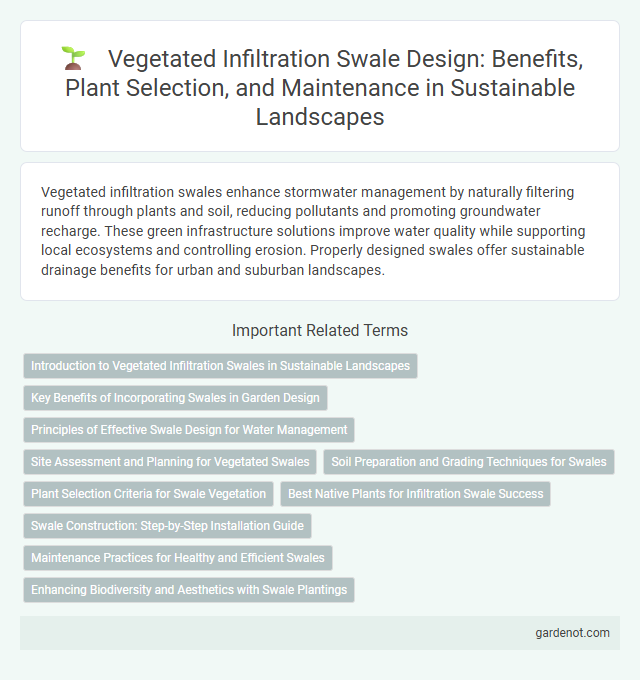Vegetated infiltration swales enhance stormwater management by naturally filtering runoff through plants and soil, reducing pollutants and promoting groundwater recharge. These green infrastructure solutions improve water quality while supporting local ecosystems and controlling erosion. Properly designed swales offer sustainable drainage benefits for urban and suburban landscapes.
Introduction to Vegetated Infiltration Swales in Sustainable Landscapes
Vegetated infiltration swales are engineered landscape features designed to manage stormwater runoff by promoting infiltration and reducing surface flow. These swales utilize native vegetation and engineered soils to filter pollutants, enhance groundwater recharge, and support biodiversity in urban and suburban environments. Incorporating vegetated swales into sustainable landscapes contributes to resilient water management systems and improves overall ecosystem health.
Key Benefits of Incorporating Swales in Garden Design
Vegetated infiltration swales enhance garden design by efficiently managing stormwater runoff, reducing soil erosion, and promoting groundwater recharge through natural filtration processes. These swales improve water quality by trapping sediments and pollutants, supporting sustainable landscaping while providing habitat for native plants and wildlife. Incorporating swales also minimizes flooding risks and decreases reliance on traditional drainage systems, contributing to resilient and eco-friendly garden environments.
Principles of Effective Swale Design for Water Management
Vegetated infiltration swales utilize permeable soil and dense plant roots to enhance stormwater infiltration and reduce surface runoff. Proper grading with gentle side slopes ensures efficient water conveyance while minimizing erosion and sediment deposition. Incorporating native vegetation with deep root systems promotes pollutant filtration and increases soil stabilization for sustainable water management.
Site Assessment and Planning for Vegetated Swales
Site assessment for vegetated infiltration swales involves analyzing soil permeability, topography, and existing drainage patterns to ensure effective stormwater management and infiltration capacity. Planning requires selecting native vegetation with deep root systems to enhance water absorption and prevent erosion while accommodating local climate and maintenance capabilities. Proper swale design integrates grading specifications and hydrologic calculations to optimize runoff reduction and pollutant filtration on-site.
Soil Preparation and Grading Techniques for Swales
Proper soil preparation for vegetated infiltration swales involves loosening compacted soil and incorporating organic matter to enhance permeability and nutrient retention. Grading techniques ensure a gentle slope, typically 1-3%, directing stormwater evenly into the swale while preventing erosion and promoting infiltration. Maintaining a level swale bottom with well-defined side slopes stabilizes vegetation growth and optimizes water capture efficiency.
Plant Selection Criteria for Swale Vegetation
Vegetated infiltration swales require plant species that demonstrate high tolerance to varying moisture levels, including periodic inundation and drought conditions, to ensure effective stormwater management. Selecting native, deep-rooted plants enhances soil permeability and stability, promoting infiltration while reducing erosion. Plants with dense foliage aid in sediment capture and pollutant uptake, optimizing the swale's overall ecological performance.
Best Native Plants for Infiltration Swale Success
Native plants such as Carex stricta (Tussock Sedge), Juncus effusus (Common Rush), and Asclepias incarnata (Swamp Milkweed) are ideal for vegetated infiltration swales due to their deep root systems that enhance soil permeability and water absorption. These species promote effective stormwater infiltration while supporting local biodiversity and reducing erosion. Selecting drought-tolerant and wetland-compatible native plants improves swale performance by maintaining soil structure and optimizing pollutant filtration.
Swale Construction: Step-by-Step Installation Guide
Constructing a vegetated infiltration swale involves grading the site to create a gentle slope that directs runoff into the swale while ensuring proper infiltration. Excavation follows, shaping the swale's trapezoidal cross-section with adequate depth and width to accommodate design stormwater volumes. The final steps include installing an engineered soil mix to promote infiltration and planting native vegetation to stabilize soil and enhance pollutant removal.
Maintenance Practices for Healthy and Efficient Swales
Vegetated infiltration swale maintenance involves regular inspection to prevent sediment buildup and ensure unobstructed water flow, which enhances infiltration and pollutant removal. Periodic removal of debris and invasive species supports plant health and maintains swale functionality. Monitoring soil moisture and addressing erosion promptly preserves the structural integrity and long-term efficiency of the swale system.
Enhancing Biodiversity and Aesthetics with Swale Plantings
Vegetated infiltration swales use native plants and diverse vegetation to improve habitat quality, supporting local wildlife and pollinators. Strategic plantings enhance the swale's aesthetic appeal while promoting water infiltration and reducing runoff, contributing to healthier ecosystems. Incorporating a variety of grasses, shrubs, and wildflowers optimizes biodiversity and creates visually attractive green infrastructure in urban or suburban environments.
Vegetated infiltration swale Infographic

 gardenot.com
gardenot.com